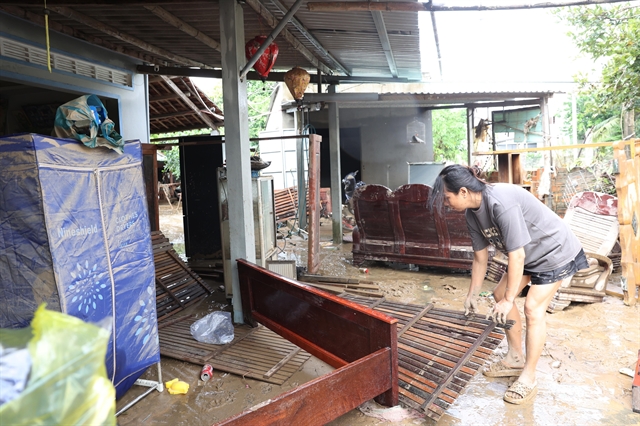 Sunday/Weekend
Sunday/Weekend

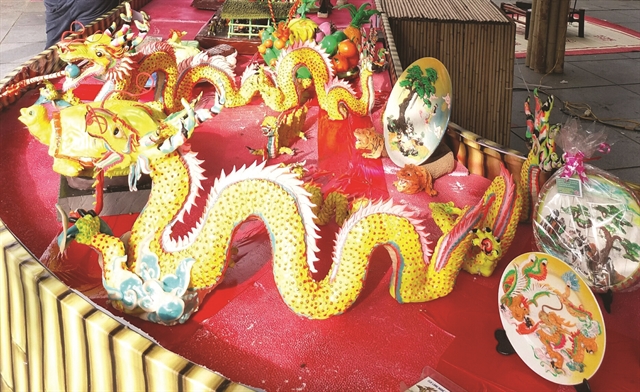 |
| MASTERPIECE: Nguyễn Văn Thành evolved the art of making toy figurines to tackle new artistic challenges, such as complex dragon scenes. Cover story |
by Nguyễn Mỹ Hà
The city of Hà Nội embraces a long list of traditional craft villages. From north, south, east and west, craft villages in the city and beyond were born centuries ago to supply to the ancient citadel of the past.
During weekends, if you take a walk along Hoàn Kiếm Lake in central Hà Nội, you can see small stands opposite Ngọc Sơn Temple selling little figurines made from rice dough in bright colours on bamboo sticks.
You will instantly recognise the familiar images of the Little Mermaid, Anna from Frozen, or Spiderman and others. You will also see the heroes of Journey to the West: Tang Sanzhang, the lead Monk, the Handsome Monkey King, and Pigsy, all much loved characters in the Chinese classic.
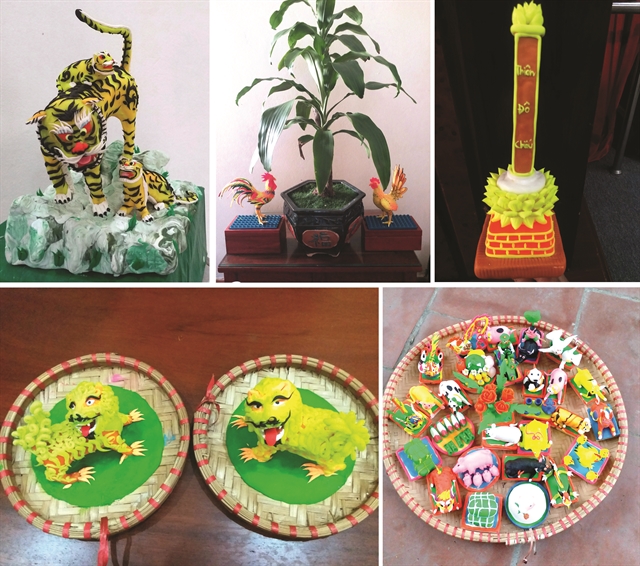 |
| HAND-CRAFTED: A large range of toy figurines in the form of animals has been created by the artisans of Xuân La Village in the suburb of Hà Nội. |
The traditional craft caters to the need of children today, but in the old days it was an age-old tradition to make small offerings to put on altars for rituals.
Using sticky rice dyed with natural colours, the craft was once to make offerings to the gods and various deities, ancestors and loved ones, but it has grown into a multi-billion đồng industry giving jobs and income to many.
Today, it's more popular for both children and adults to prepare for fun. Like colourful clay, it is healthy and safe, smells naturally good, and can also be eaten if desired.
If you travel on National Highway 1A south from Hà Nội for 50km, you’ll arrive in Xuân La Village in Phú Xuyên District. This is the home of the tò he craft.
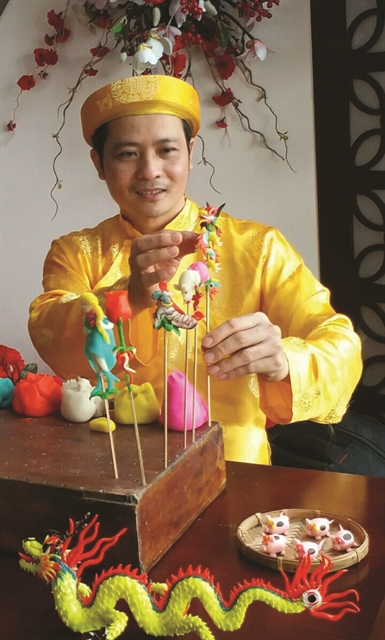 |
| MAN AT WORK: People's Artisan Nguyễn Văn Thành now teaches the art of making toy figurines to school children. VNS Photos Đoàn Tùng |
Today tò he is a safe and creative visual art craft, which anyone can delve into, but many years ago, during the war, it was considered a useless craft, that didn't provide any vital essentials for human existence.
Like any traditional craft over hundreds of years old, the craft has gone through tough times during war and famine, with a lack of interest and clients. But the art, which used to depict the traditional stories and legends, has lived on.
Today, the craft of making tò he has been recognised as an age-old craft of Xuân La Village, handed down from fathers to children.
The Tò he guild of Xuân La has more than 400 households practising the craft, creating jobs for more than 1,500 people in the village.
Tò he is a craft toy for children. The figurines are edible because they are made from the rice dough. Originating in the Red River basin delta, the craft is something that immigrants brought with them when they travelled to the south to search for new opportunities.
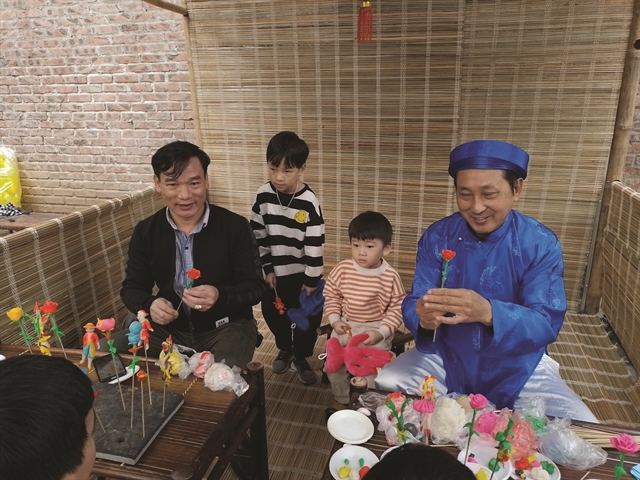 |
| FAMILY FUN: Artisan Nguyễn Văn Định, 63, (first right) crafts a red rose from rice dough |
The toys were made first to be placed as an offering to ancestors and were made into animals such as peacocks, chickens, buffaloes and cows, pigs and fish. Other items were also added to the altars, such as bananas, areca nuts, pork leg, or a sticky rice dish to make a full tray of offerings, which could be taken to a pagoda.
In Xuân La, almost everyone can make toys of their own. But only three craftsmen have been recognised as Hà Nội’s artisans: Đặng Văn Hạ, Nguyễn Văn Ấu and Nguyễn Văn Thành.
The artisans’ life was usually spent at country fairs and festivals. They would leave home and go from one village fair to another, preparing their work materials as they went.
The dough is made from cooked sticky rice, mashed together and mixed with natural dyes to make the four traditional colours: red, bright yellow, blue and black. They then mix these colours together to make new ones if desired.
The most well-known tò he artisan today is Nguyễn Văn Thành, 45, whom fellow villagers have voted as the most amazing talent involved in the art form.
He made a record by creating a mini model of the Thăng Long Citadel entirely from rice dough. He even travelled to China and Thailand to demonstrate his craft to an international audience. Thành lifted the craft of tò he by sending his works to the country’s National Arts Exhibition, organised every 5 years, and was awarded the title of Artisan Emeritus in 2015.
In 2022, Nguyễn Văn Thành made his name in the honourable list of People’s Master Artisans. Having chaired the village’s Tò He Guild for more than 10 years, Thành organised a series of competitions for the best tò he artisan. The guild as well as the number of self-taught artisans has grown year-on-year.
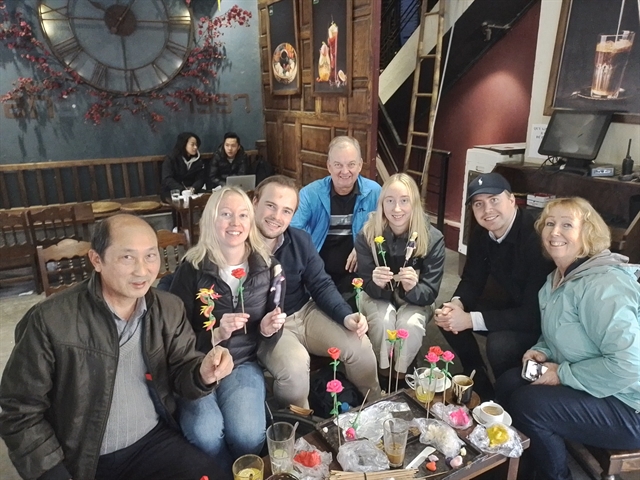 |
| FOREIGN FRIENDS: Visitors go to Xuân La Village to enjoy the art of tò he under the instruction of Artisan Nguyễn Văn Định. |
Master artisan Thành can make almost anything from the rice dough: from artistic portraits and traditional cakes and buns, to the twelve zodiac animals and traditional figurines from legends as well as cartoons. He has been invited to demonstrate his art at international cultural shows, trade fairs, exhibitions and birthday parties.
Since he made it into a form of visual arts, Nguyễn Văn Thành has been invited to teach his arts to students in schools and colleges in Hà Nội as well as invited on to many television shows.
In Xuân La today, the people still preserve the ancient altar house, worshipping the founding father of the tò he craft. The annual village craft day falls on the eighth lunar month, which is October 4 this year. Festivities will be held, and many figurines made in the village during the celebrations.
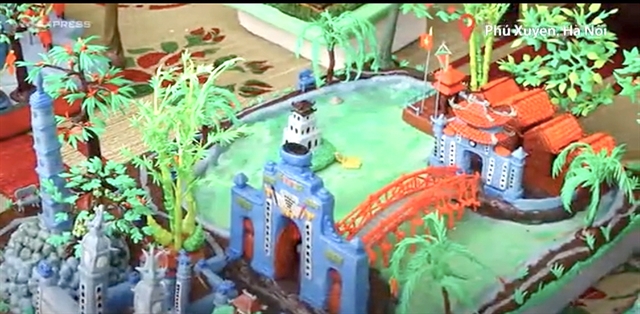 |
| MODEL TEMPLE: A miniature of Hoàn Kiếm Lake scenery crafted by artisans of Xuân La led by Nguyễn Văn Thành. Photo courtesy of the Artisa |
"Tò he can only last between one and two weeks," Thành said of the only setback of the art. He and other artisans are trying to find a way to make the figurines last longer.
During his tenure chairing the Tò he Guild of Xuân La, Thành brought together other artisans to make an ambitious collection of 15 landscapes in Hà Nội.
"It took us a week to complete each scene," he said. "And for complex pieces, three to four artisans had to work together for a week."
Yet, after only one week, the masterpieces they worked so hard on had to be dismantled.
Old village documents depicting the history and tradition of the craft have been well-preserved but are scattered in libraries in the Social Sciences Academy and National Archives Centre. Having thrived over the years, the tò he craft still lives on to reflect the soul and story-telling of the people.
Fans of this art can easily learn to make a basic entry level tò he. If you want to master all the basic figures, it takes about three months to learn.
"But a talented learner with great imagination, paying close attention to detail, can craft their first figurines to be sold in the walking district after just a week," Thành said. VNS


